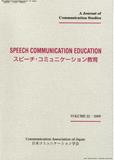22 巻
選択された号の論文の22件中1~22を表示しています
- |<
- <
- 1
- >
- >|
表紙・目次
-
原稿種別: 表紙
2009 年 22 巻 p. Cover1-
発行日: 2009/03/31
公開日: 2017/11/30
PDF形式でダウンロード (21262K) -
原稿種別: 目次
2009 年 22 巻 p. Toc1-
発行日: 2009/03/31
公開日: 2017/11/30
PDF形式でダウンロード (48K)
特別企画 I
-
原稿種別: 中扉
2009 年 22 巻 p. 5-
発行日: 2009/03/31
公開日: 2017/11/30
PDF形式でダウンロード (22K) -
原稿種別: 本文
2009 年 22 巻 p. 7-9
発行日: 2009/03/31
公開日: 2017/11/30
PDF形式でダウンロード (308K) -
原稿種別: 本文
2009 年 22 巻 p. 11-19
発行日: 2009/03/31
公開日: 2017/11/30
PDF形式でダウンロード (787K) -
原稿種別: 本文
2009 年 22 巻 p. 21-30
発行日: 2009/03/31
公開日: 2017/11/30
PDF形式でダウンロード (1069K) -
原稿種別: 本文
2009 年 22 巻 p. 31-36
発行日: 2009/03/31
公開日: 2017/11/30
PDF形式でダウンロード (604K) -
原稿種別: 本文
2009 年 22 巻 p. 37-46
発行日: 2009/03/31
公開日: 2017/11/30
PDF形式でダウンロード (989K)
特別企画 II
-
原稿種別: 中扉
2009 年 22 巻 p. 47-
発行日: 2009/03/31
公開日: 2017/11/30
PDF形式でダウンロード (14K) -
原稿種別: 本文
2009 年 22 巻 p. 49-52
発行日: 2009/03/31
公開日: 2017/11/30
PDF形式でダウンロード (409K) -
原稿種別: 本文
2009 年 22 巻 p. 53-65
発行日: 2009/03/31
公開日: 2017/11/30
PDF形式でダウンロード (1283K) -
原稿種別: 本文
2009 年 22 巻 p. 67-76
発行日: 2009/03/31
公開日: 2017/11/30
PDF形式でダウンロード (974K) -
原稿種別: 本文
2009 年 22 巻 p. 77-88
発行日: 2009/03/31
公開日: 2017/11/30
PDF形式でダウンロード (1287K) -
原稿種別: 本文
2009 年 22 巻 p. 89-95
発行日: 2009/03/31
公開日: 2017/11/30
PDF形式でダウンロード (716K) -
原稿種別: 本文
2009 年 22 巻 p. 97-115
発行日: 2009/03/31
公開日: 2017/11/30
PDF形式でダウンロード (1866K)
研究論文
-
原稿種別: 本文
2009 年 22 巻 p. 117-139
発行日: 2009/03/31
公開日: 2017/11/30
PDF形式でダウンロード (2245K) -
原稿種別: 本文
2009 年 22 巻 p. 141-161
発行日: 2009/03/31
公開日: 2017/11/30
PDF形式でダウンロード (1917K)
執筆要領・投稿規定・執筆者情報など
-
原稿種別: 付録等
2009 年 22 巻 p. 162-163
発行日: 2009/03/31
公開日: 2017/11/30
PDF形式でダウンロード (135K) -
原稿種別: 付録等
2009 年 22 巻 p. 164-166
発行日: 2009/03/31
公開日: 2017/11/30
PDF形式でダウンロード (150K) -
原稿種別: 付録等
2009 年 22 巻 p. 167-168
発行日: 2009/03/31
公開日: 2017/11/30
PDF形式でダウンロード (127K) -
原稿種別: 付録等
2009 年 22 巻 p. 168-169
発行日: 2009/03/31
公開日: 2017/11/30
PDF形式でダウンロード (100K) -
原稿種別: 付録等
2009 年 22 巻 p. App2-
発行日: 2009/03/31
公開日: 2017/11/30
PDF形式でダウンロード (62K)
- |<
- <
- 1
- >
- >|
